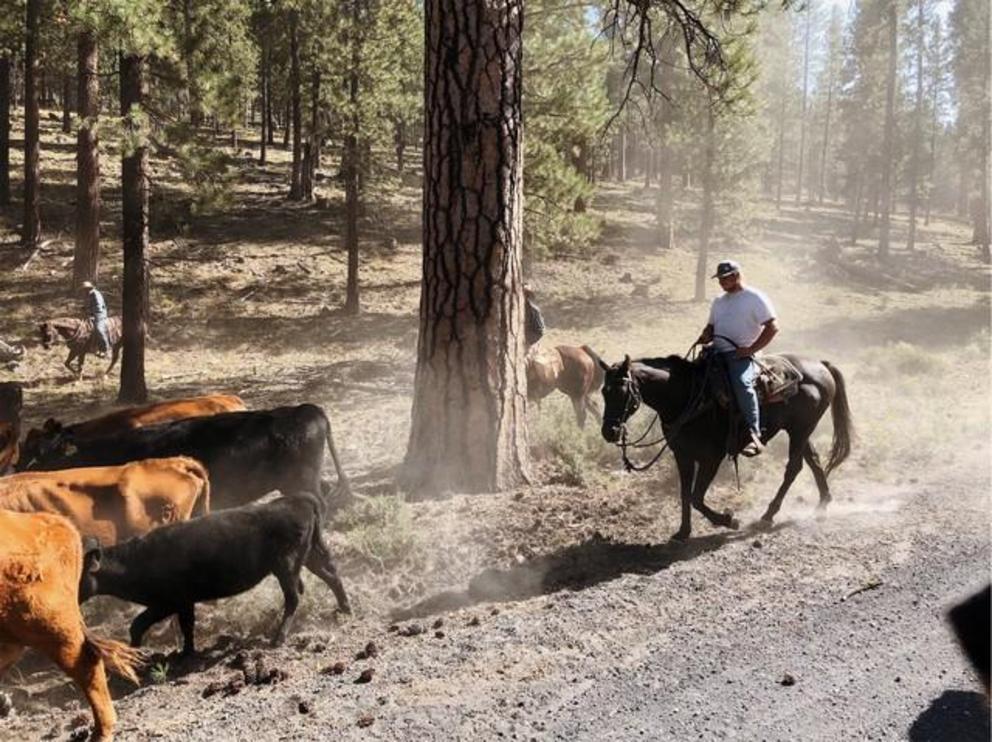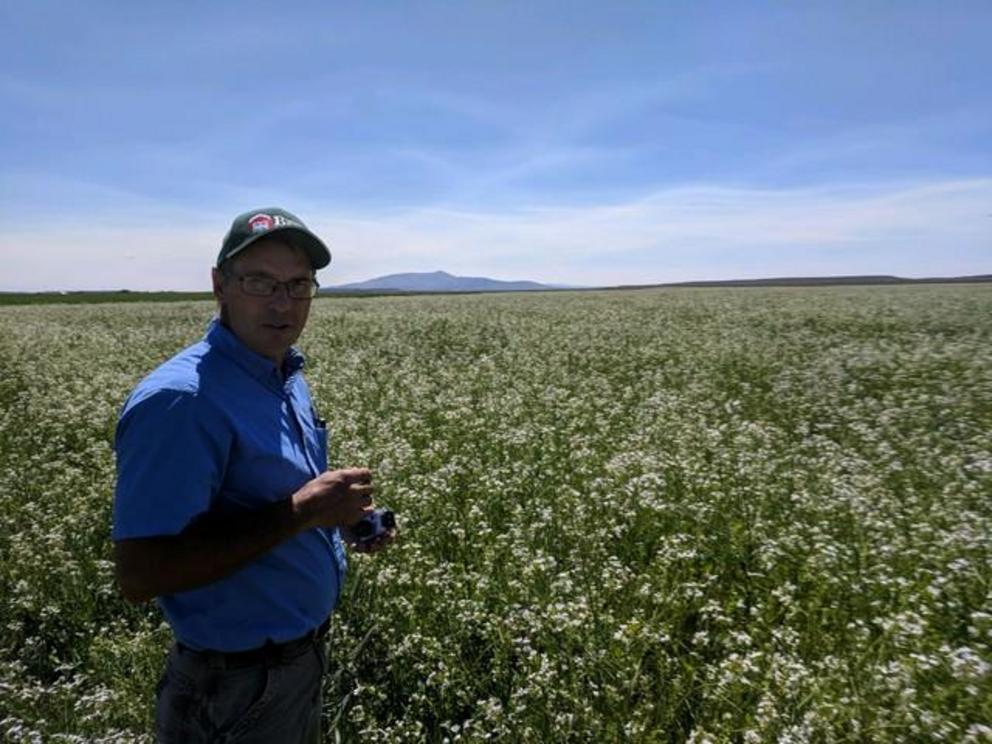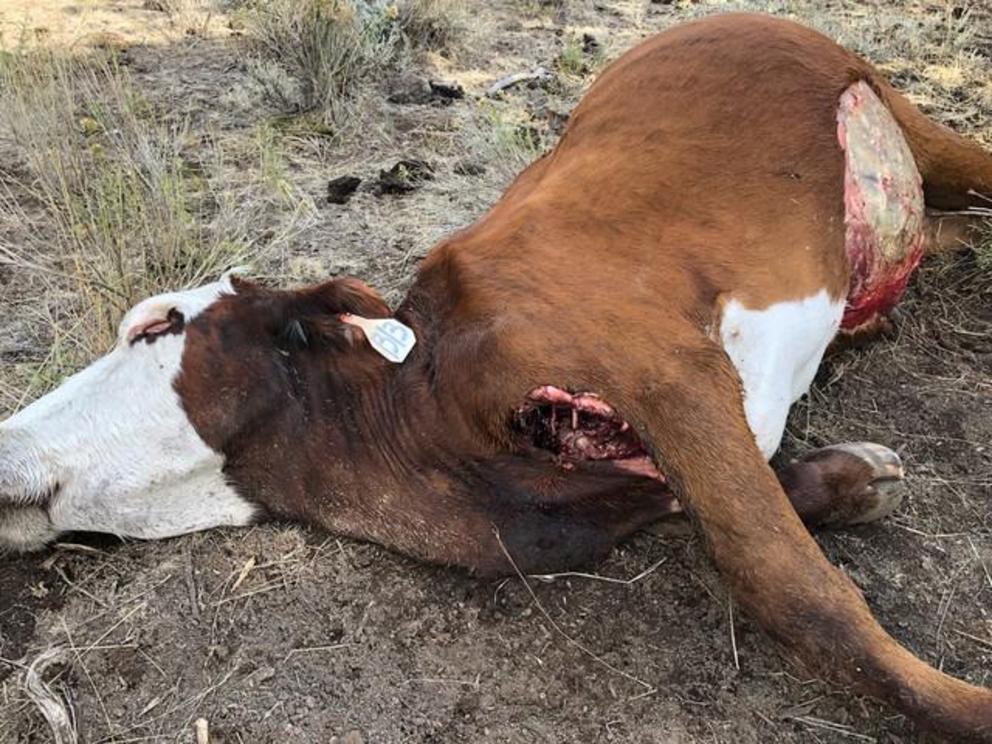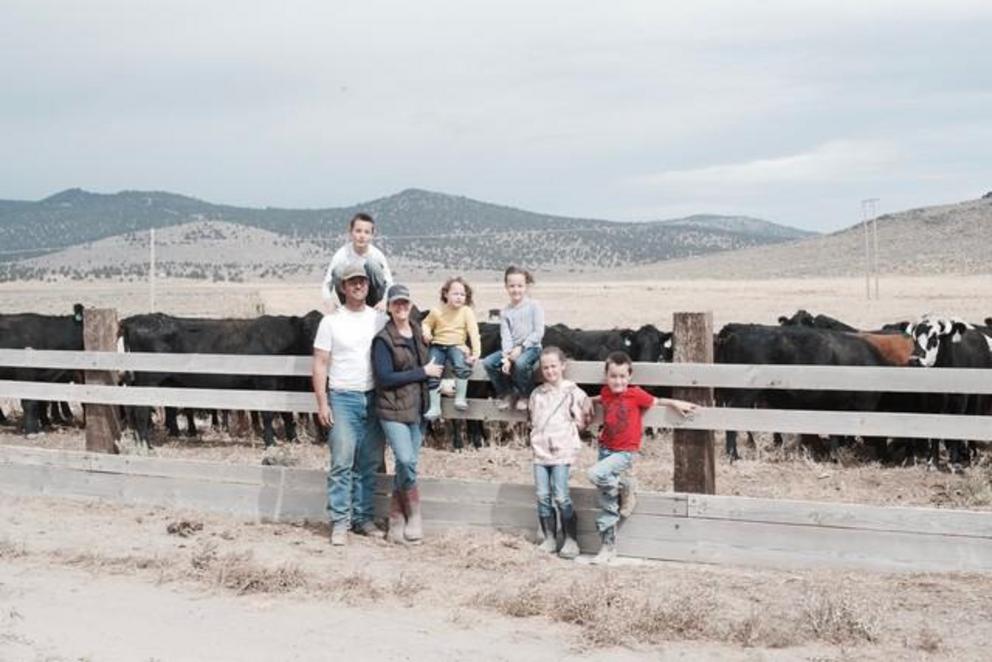Another mutilated cow In central Oregon rattles ranchers
Rancher Stephen Roth is rattled by the recent slaying of one of his cows near Hampton, Oregon.
“You’re scared to go out without a gun,” he said. “You have to weigh the danger of packing a gun versus having it around your young kids.”
Roth has five little children, so he’s reluctant to carry guns in his vehicle or on horseback.
The cow’s killing happened in September 2019, but records have just recently been released on the case from the Lake County Sheriff’s Office, and it still feels fresh to Roth.
NOTE: This story includes images and descriptions of dead cows and their mutilation that readers may find disturbing.
Out There
Between the private ground and public lands, Roth’s family manages about 87,000 acres of sage, juniper and sand. They run more than 1,000 head of cattle and grow irrigated alfalfa on their land.
Roth’s ranch hand found the slain cow in the late afternoon of Sept. 18. She was missing her udder, genitals, tongue, blood and heart.
“My cowboy was out checking water,” Roth said. “He’d been out the day before. She was within a couple hundred yards of the water trough.”
The cow was mutilated in a remote stretch of U.S. Bureau of Land Management land in northern Lake County.
Roth says it takes about an hour to drive there on a rough road with a high pickup or 4-wheel drive vehicle.
According to Clancy Roth, Stephen’s wife, there are only five ranches for about 60 miles – between their place and Bend, Oregon.

Kaden Wiberg is a ranchhand at the Roth family ranch in central Oregon. He was one of the first people to spot a dead and mutilated cow in September 2019. Courtesy of Kaden Wiberg
“There’s nothing out there, but us,” Clancy Roth said. “It’s creepy to think some weirdo is out there.”
Later that day, ranch owner Stephen Roth came out to inspect the animal. He tried to get help. He called the Harney County Sheriff’s Office because he knew it was handling the recent cases of five bulls that were slain on Silvies Valley Ranch.
As we’ve previously reported, five young bulls were slain last year on an expansive working and guest ranch that’s roughly the size of Chicago. The animals were killed on remote U.S. Forest Service allotments. Their tongues, genitals and blood were removed. Ranchers say scavengers like birds and coyotes didn’t touch the dead animals. The ranch’s owner offered a $25,000 reward for information leading to a conviction, but so far there are no suspects.
Back in Lake County, Roth’s cow was out of the Harney Sheriff’s Office jurisdiction. He called the Lake and nearby Deschutes counties. He called the Oregon State Patrol, which also wouldn’t respond.
Roth wanted forensic testing of the animal to see if it had been poisoned or darted. There were no bullet holes in the hide.
“The Harney County people said that I could hire the vet to come out,” Roth said, “but I really didn’t want to be out there in the dark with the vet and no guns.”
The next day, Lake County deputy Tom Roark came to inspect the animal, but it was too late to take a blood sample.
The deputy’s report says: “ … I began an investigation involving the mutilation of a cow, Steven Roth being the animal owner. The mutilation included the heart, tongue, udder, vagina and butt being cut from the cow. There is no suspect information.”
The Tracker
Looking for more clues as to who, or what, killed his cow, Stephen Roth invited over his long-time friend Gary Bishop, who had served in the U.S. Air Force in a tactical reconnaissance unit. They went out to where the cow was killed, with the sheriff’s deputy.
“It’s a hobby of mine to track stuff for hunting,” Bishop said.
He recounts that the scene was incredibly strange.
“It’s obvious an animal didn’t do it,” he said. “I think [whoever is responsible] rely on the fact that we are so rural that they can’t get the animal to a vet for a forensic exam fast enough.”

Gary Bishop is a veteran of the U.S. Air Force and now works as a consulting agronomist. Here he’s in a blooming field of radish in Deschutes County, Ore. Courtesy of Gary Bishop
He described the killer as extremely efficient, and good at what they’re doing.
“When an animal is killed hunting, usually you gut it right on site so you can move it,” Bishop said. “You can see that disturbance on the ground. The person that’s doing this is getting away with this but is very efficient at it. They’ve been doing it a long time or they are in a trade that they know how to skin an animal.”
The rancher and his friend found prints behind a juniper tree where someone may have kneeled down near the dead cow.
They also found some feathers scattered on the nearby brush that they thought might have been used as packing on a blow dart. They collected the feathers with the sheriff’s deputy for analysis.
“It looks like ostrich plume, white or grey colored feathers,” Bishop said. “They’re fluffy enough they’re not synthetic. They were scattered in a straight line from some trees to the animal, hung up in the sage and the grass.”
Roth sent a feather to the Harney County Sheriff’s Office for analysis, but officials later told them they were from a common bird of the area, and likely not packing for a dart.
Bishop said he thought someone would have had to have watched the cattle for a day or two to see how the animals were moving back and forth to the water.
“If you were trying to do this, I would go out into that animal’s territory and track him for a couple of days,” he said. “Cows are a little more predictable.”
But he’s livid about the whole incident.
“Our livelihood out here in the desert is cattle,” Bishop said. “You get to know your critters, no matter how big your herd is. And that these people have such disregard for the animal and the value of it. It’s just a violating feeling.”
Creepy Details
Some of the most disturbing parts of the cow’s killing are the details, says Stephen Roth.
The number on the cow’s yellow plastic ear tag was “1313.”
And she was found a few days after Friday the 13th.
“To be able to cut through skin and hide without getting into the belly, takes a lot of skill and precision,” said Kaden Wiberg, one of Roth’s ranch hands who first came upon the killed cow. “It kind of creeped me out. I definitely think it was someone, a pretty sick person. It wasn’t an animal. No animal can cut skin around a belly like that.”
Wiberg says there were no distinguishable foot, truck or ATV prints or other clues nearby.
The cow was found near the water troughs, not in the middle of the range.

In this photo you can see the place where the heart was cut out and where the udder cut away from the belly of the young cow, number 1313 Courtesy of Kaden Wiberg
“I wonder if they wanted us to find it to spook us. I don’t know,” he said.
Wiberg said there were a few thrash marks where the cow had moved around on the ground.
One other detail was strange.
Wiberg got really sick after he touched the dead cow.
“He was throwing up,” said Clancy Roth. “We don’t know if he got a flu bug, or ate something – but he went out there looked at that cow and touched her and then that night he wasn’t fine.”
Clancy Roth says that Wilberg was the only person from the ranch who got sick, and the only one who touched the cow.
Second Time
This is the second time this family has been hit by a cattle killer.
In the early 1990s, four cattle were killed on David Roth’s ranch. David, who is 76, is Stephen’s father. David’s ranch is in Lake County, on a U.S. Forest Service allotment about 30 miles east of La Pine.
“It was disgusting and disappointing,” the elder Roth remembered.
The cattle were mostly black-baldies, and one was a Hereford.
“Each [killing] was at a different time, over a span of about six weeks,” he said. “In that open country, you don’t see your cows every day.”
The cases were reported to the Lake County Sheriff’s Office, which investigated, but no suspects were ever found.

Stephen and Clancy Roth have five small children, and the recent mutilation of a cow on their rangeland in central Oregon has them rattled. Courtesy of Stephen and Clancy Roth
“Anytime someone messes with your cattle it makes you mad,” David Roth said. “We thought it was some sort of cult, not what normal people would do to property or animals.”
Roth says to his knowledge there wasn’t anyone with a vendetta against his family and other ranching neighbors had the same kind of cattle killings too. A lot of times he would find the animals several days after they’d been killed – and there were no signs of who or what did the crime.
“We’re just amazed that this is happening again,” David Roth said. “It’s something we just don’t understand.
No Peace
The animal is worth around $1,200 and wasn’t insured for this type of incident, so it’s a total loss, Stephen Roth said.
But more than that, it’s frustrating to Roth’s family and employees.
“It’s a lot more than money,” he said. “You raise [the cattle] from heifers. You take care of them and raise them up, see their calves born. You know them.”
However upsetting, these cases are intrinsically hard to solve. They’re remote. There are few or no witnesses. And they’re the responsibility of short-staffed counties or law enforcement jurisdictions.
“Because we are so spread out, how many more are there that we don’t even find?” Clancy Roth said. “You have to be lucky to even trip across [dead and mutilated cattle].”
She said her family and the ranch hands carry pistols now.
“There’s not much we can change unless you just don’t run cows,” she said.
But that’s frustrating to ranchers who have lost one of the big reasons they chose to live so remote: peace.
“If someone comes up to the house, we’re fairly prepared,” Stephen Roth said. “But when we’re out on the range you want to be friendly to people, not scared of them.”
He used to let his 12-year-old son ride to gather cattle with him. Sometimes the boy can disappear over a hill or down a draw, through trees and out of his sight. Stephen Roth said now he might have to keep a tighter rein on his range-savvy son.
“That [killing] makes you think a little more,” Roth said.
